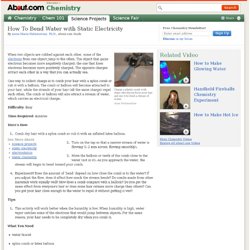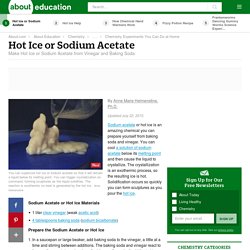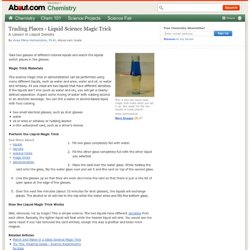

Bending Water with Static Electricity. When two objects are rubbed against each other, some of the electrons from one object jump to the other.

The object that gains electrons becomes more negatively charged; the one that loses electrons becomes more positively charged. The opposite charges attract each other in a way that you can actually see. One way to collect charge is to comb your hair with a nylon comb or rub it with a balloon. The comb or balloon will become attracted to your hair, while the strands of your hair (all the same charge) repel each other. The comb or balloon will also attract a stream of water, which carries an electrical charge. Difficulty: Easy Time Required: minutes Here's How: Comb dry hair with a nylon comb or rub it with an inflated latex balloon. Tips: This activity will work better when the humidity is low. John Travoltage - Voltage, Static Electricity, Electricity.
Hot Ice or Sodium Acetate - Make Hot Ice or Sodium Acetate from Vinegar and Baking Soda. Updated July 22, 2015.

Sodium acetate or hot ice is an amazing chemical you can prepare yourself from baking soda and vinegar. You can cool a solution of sodium acetate below its melting point and then cause the liquid to crystallize. The crystallization is an exothermic process, so the resulting ice is hot. Solidification occurs so quickly you can form sculptures as you pour the hot ice. continue reading below our video Play Video The sodium acetate in the solution in the refrigerator is an example of a supercooled liquid. As you would expect, sodium acetate is a safe chemical for use in demonstrations.
Are available that should help solve any problems you may encounter with this project. Schools Science Clips - Changing state. Diving Ketchup Magic Trick - Make a Ketchup Packet Cartesian Diver. Place a ketchup packet in a bottle of water and make it rise and fall at your command, as if by magic.

Of course, the magic involves some basic science. Here's how to do the diving ketchup trick and how it works. Diving Ketchup Magic Trick Materials plastic bottle ketchup packet from a fast food restaurant water Perform the Diving Ketchup Magic Trick. Trading Places - Liquid Science Magic Trick. Take two glasses of different-colored liquids and watch the liquids switch places in the glasses.

Magic Trick Materials This science magic trick or demonstration can be performed using many different liquids, such as water and wine, water and oil, or water and whiskey. All you need are two liquids that have different densities. If the liquids don't mix (such as water and oil), you will get a clearly-defined separation. Expect some mixing of water with rubbing alcohol or an alcoholic beverage. Perform the Liquid Magic Trick Fill one glass completely full with water. How the Liquid Magic Trick Works Well, obviously not by magic! Density - Density, Mass, Volume. Gas Properties - Gas, Pressure, Volume.
Topics Ideal Gas Law Kinetic Molecular Theory Diffusion PV Work Maxwell-Boltzmann Distribution Description Pump gas molecules to a box and see what happens as you change the volume, add or remove heat, and more.

Measure the temperature and pressure, and discover how the properties of the gas vary in relation to each other. Examine kinetic energy and speed histograms for light and heavy particles. Sample Learning Goals Determine how changing a variable among P, V, N, and T influences other gas properties.Describe the relationship between particle-wall collisions and pressure.Predict how changing temperature will affect the speed of molecules.Predict the speed of molecules in thermal equilibrium based on the relative masses of molecules.
Version 1.0.4 HTML5 sims can run on iPads and Chromebooks, as well as PC, Mac, and Linux systems. iPad: iOS 12+ SafariiPad compatible sims. Water into Wine Demonstration. This popular chemistry demonstration is often called turning water into wine or water into blood.

It's really a simple example of a pH indicator. Phenolphthalein is added to water, which is then poured into a second glass containing a base. If the pH of the resulting solution is right, you can make the water turn from clear to red to clear again, as long as you like. Watch the Video of This Project Difficulty: Easy Time Required: Minutes Here's How: Sprinkle sodium carbonate to coat the bottom of a drinking glass.Fill a second glass halfway full of water. Tips: Phenolphthalein and sodium carbonate can be ordered freely from any scientific supplier. What You Need phenolphthalein pH indicatorsodium carbonatewater2 glassesstirring rodstraw or pipette.